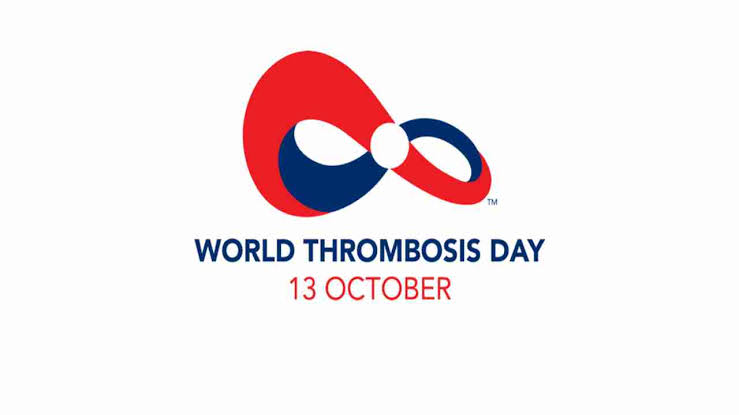World Thrombosis Day – October 13, 2022, history, significance
World Thrombosis Day is observed by the entire world on October 13. The International Society on Thrombosis and Haemostasis created the World Thrombosis Day campaign in 2014 to bring awareness to the frequently disregarded and misunderstood condition of thrombosis.
Globally, thrombosis-related disorders cause one in every four deaths. And, astonishingly, blood clots affect up to 900,000 people in the United States alone each year; about 100,000 of them will pass away, which is greater than the total annual death toll from AIDS, breast cancer, and automobile accidents.
HISTORY OF WORLD THROMBOSIS DAY

As scientists, researchers, and healthcare professionals, you are aware that heart attack, stroke, and venous thromboembolism are the top three causes of cardiovascular death worldwide. Thrombosis is the most common disease-causing these events (V.T.E.). Many of these deaths can be prevented, though.
Thrombosis is a medical disorder that occurs when blood clots clog blood vessels. Venous thrombosis and arterial thrombosis are the two forms of thrombosis. When a blood clot stops a vein, this is known as venous thrombosis. When a blood clot plugs an artery, this is referred to as arterial thrombosis.
Thrombosis affects up to 900,000 people in the United States alone each year. Many people who have venous thrombosis will have long-term consequences. Some of these symptoms include swelling, discomfort, and skin discoloration. Each year, up to 100,000 individuals in the United States die as a result of thrombosis. On a worldwide scale, one in every four people dies as a result of thrombosis-related illnesses.
The first World Thrombosis Day will be held on October 13, 2014, to raise awareness of this critical health concern. World Thrombosis Day is an educational project led by the International Society on Thrombosis and Haemostasis (I.S.T.H.) and overseen by prominent medical and public health specialists to lower the considerable illness burden caused by thrombosis.
The goal of World Thrombosis Day is to raise global awareness of thrombosis, including its causes, risk factors, signs and symptoms, and evidence-based prevention and treatment. Finally, the effort aims to minimize the number of people who die or are disabled as a result of the condition.
The World Thrombosis Day mission supports the World Health Assembly’s worldwide goal of lowering noncommunicable disease-related premature deaths by 25% by 2025, as well as the World Health Organization’s global action plan for noncommunicable disease prevention and control between 2013 and 2020.
WORLD THROMBOSIS DAY TIMELINE
1271
First Well-Documented Case of Thrombosis
Raoul experiences unilateral edema in the ankle that spread to the leg.
1600
Clots Forming in Blood Vessels
Mercurialis notices clots occurring in blood vessels at normal body temperature.
1628
Blood Circulation Study
William Harvey, an English physician, presents the first research on blood circulation.
2014
Educational Initiative
The first World Thrombosis Day is held on October 13 to raise awareness about this significant health concern.
HOW TO OBSERVE WORLD THROMBOSIS DAY
Learn more about thrombosis
Learn more about thrombosis and discuss the dangers with your doctor. Learn about renowned thrombosis survivors, including Hillary Clinton, Serena Williams, and James Stewart.
Share it on social media
If you have survived thrombosis, please share your experience with others by using #WorldThrombosisDay. You can ever share symptoms and what to look for on your social media.
Participate in an event
Live webinars, instructive seminars, distinguished speakers, and a design contest are among the events. Interviews with thrombosis survivors and medical experts are also included.
5 FACTS ABOUT THROMBOSIS
May have no symptoms
Blood clots might be asymptomatic or cause your limb or arm to enlarge and ache.
Blood clots can break loose
Blood clots can break free and move to your lungs (pulmonary embolism), causing breathing issues and perhaps death.
Some patients are more vulnerable
People with autoimmune illnesses, such as lupus, and those living with H.I.V. are also at an increased risk for V.T.E.
No routine screening
Routine screening tests for common illnesses such as diabetes and high cholesterol are available, but there are no evidence-based screening tests for blood clots.
Lifestyle is important for prevention
Some risk factors, such as age or family history, are unchangeable, but behaviors are.
WHY WORLD THROMBOSIS DAY IS IMPORTANT
It raises awareness
Increase public and health professional knowledge of the prevalence and hazards of thrombosis, as well as take action. You can do this through educational programs throughout the year.
It links to people who are experiencing the same issue
World Thrombosis Day encourages individuals to live a healthier lifestyle. Individuals begin to encounter new people who can connect with and understand them by watching the day and participating in healthy activities.
It brings us together for a good cause
People throughout the world are united by the shared goal of improving health. This is encouraged and should be done regularly.



